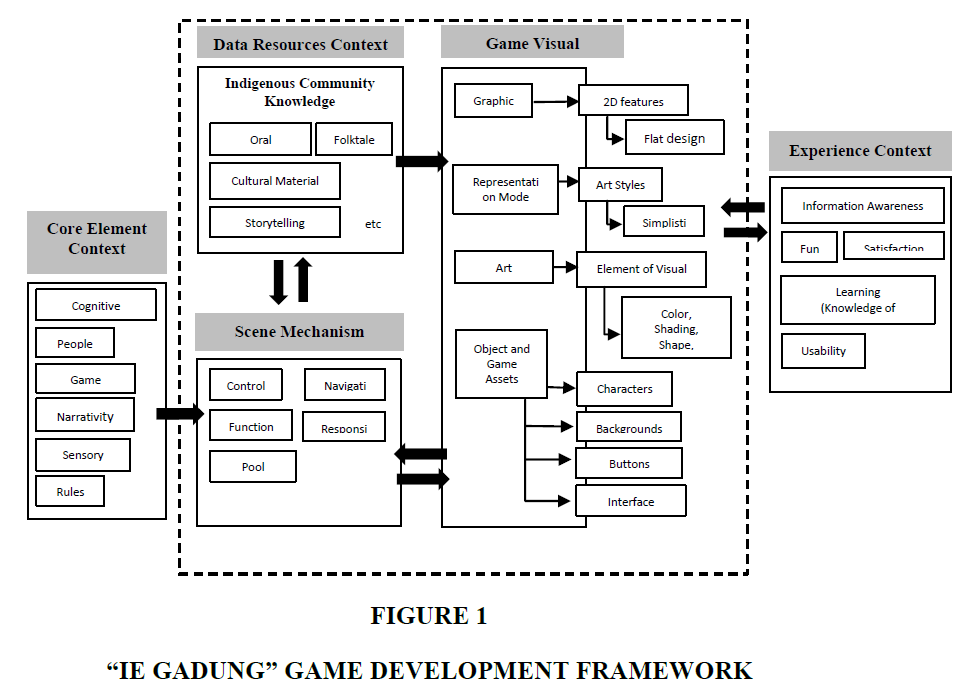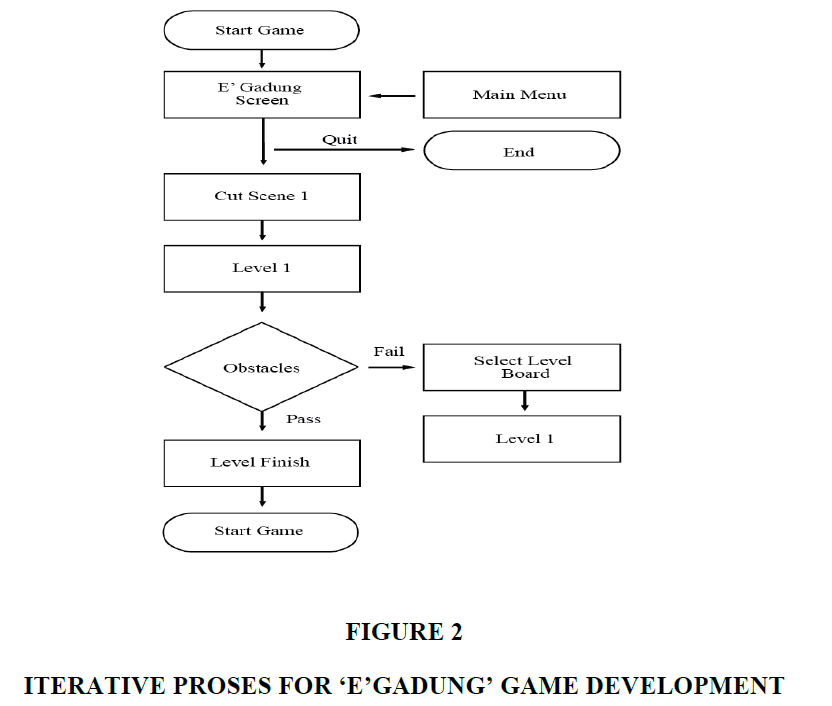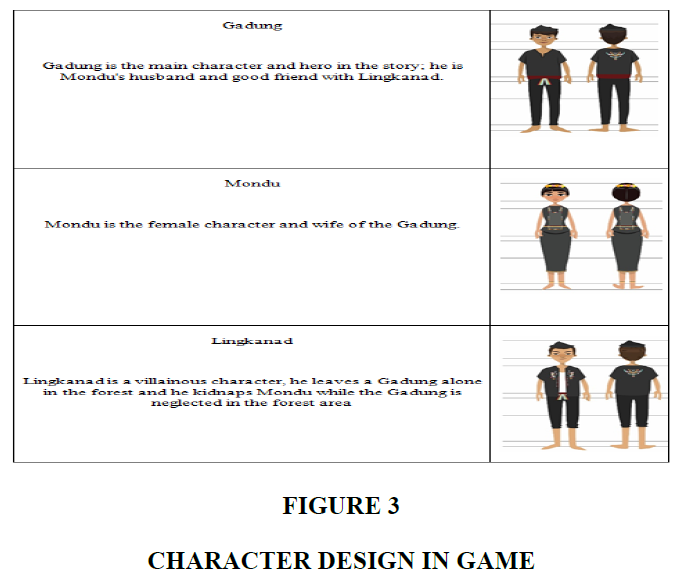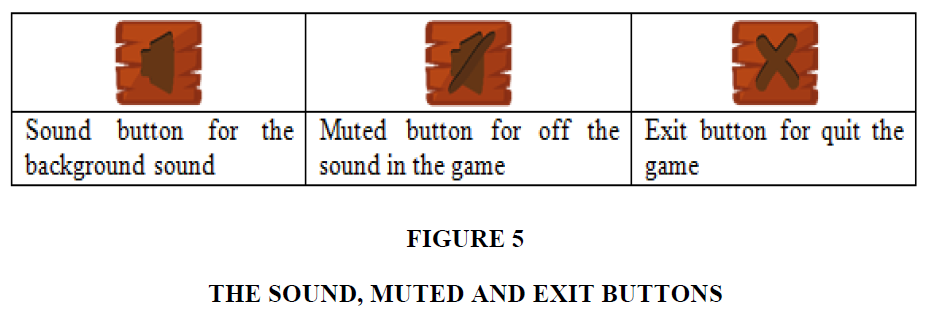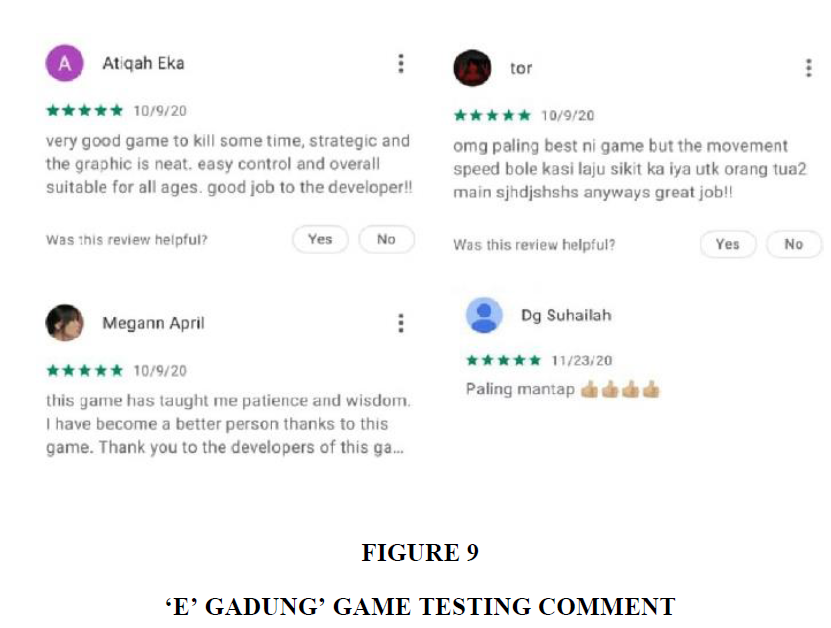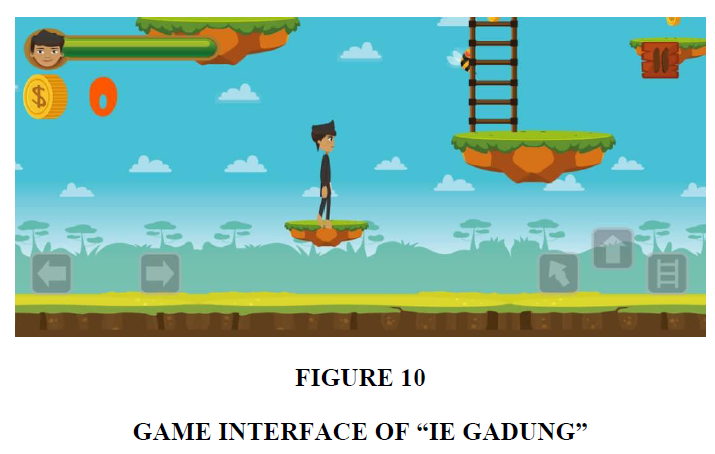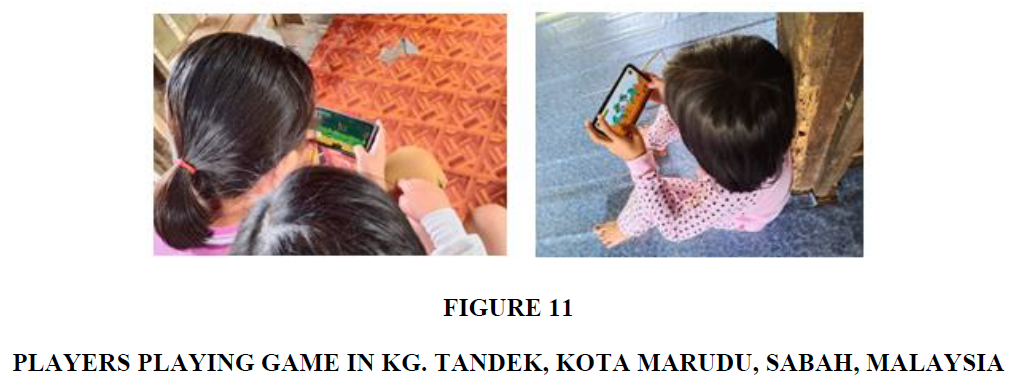Research Article: 2022 Vol: 25 Issue: 1S
Kimaragang folklore game app development: E-GADUNG
Lilian Lee Shiau Gee, Universiti Malaysia Sabah
Victor B. Pangayan, Universiti Malaysia Sabah
Danial Kordmodanlou, Amirkabir Unversity of Technology
Citation Information: Shiau Gee, L. L., Pangayan, V. B., & Kordmodanlou, D. (2022). Kimaragang folklore game app development: ‘E’ GADUNG’. Journal of Management Information and Decision Sciences, 25(S1), 1-13.
Abstract
Digital games have evolved as a crucial interactive media capable of encouraging and fostering cultural heritage through visualisations, with a special emphasis on preserving and maintaining Sabahan folklore for future generations. This paper discusses the development of the E'Gadung app as well as the outcomes of a study on Kimaragang ethic group preservation. A documentary analysis, prototyping, playtesting and semi-structured interview has been carried out. The results indicate that the digital game significantly increased the Kimaragang group's awareness of the importance of protecting local cultural heritage. Additionally, positive youth responses have shown that the game 'E' Gadung' has been successfully presented using a combination of artistic elements to educate younger generations, especially Kimarang ethnic children aware to their own culture and heritage. Thus, it is necessary to address "continuous process" digitalization strategies in order to preserve knowledge of intangible cultural resources, particularly Sabah's ethnic folklore.
Keywords
Digital game; Folktales; Safeguard; Kimaragang ethnic; Game design.
Introduction
Technology's growth over time has revealed its relevance to our daily lives, and these advancements have contributed to technology's digital dominance in conserving information, cultural heritage, manuscript documentation, and artefacts. Certain attempts, such as digitising cultural heritage, are being made to keep it from fading or becoming extinct. As can be seen, a substantial amount of folklore digitization research has been conducted, with the goal of preserving tradition while also educating and entertaining audiences (Harun & Jamaludin, 2016). Nevertheless, developments are still in their infancy, notably in terms of digital preservation strategies for storytelling and continuously dwindling collections of indigenous Sabah folklore, and ethnic youths continue to lack a feeling of cultural awareness. It provides insight into the potential of mobile technology in an endeavour to preserve folklore through effective digitalization, owing to digital technology's creative imaging and multimedia capabilities. The expanding popularity and market for smartphones and tablets indicates how efficient mobile technology can be for transmitting various aspects of indigenous oral traditions.
The capacity of mobile technology to preserve folklore, the approach and inventiveness of interactive gaming in bringing cultural heritage closer to the lifestyles of the younger generation. Additionally, the game's multimedia aspects, narrative, and feedback make it an excellent medium for recreating indigenous content, and the game's presentation and delivery process boost its ability to arouse public interest in indigenous knowledge. The purpose of this study is to investigate a possible application gaming technique for resurrecting Sabah folklore, particularly in the global digital society. This study focused on structure, character, visual components, and narrative features as a means of comprehending and communicating the application's game design style as an innovative technique of revitalizing indigenous folklore via an engaging virtual world. This selection is a part of an art and design aspect that will have a simple two-dimensional style of characterization. The purpose of this paper is to develop and construct two-dimensional application games based on Kimaragang Sabah ethnic folklore, specifically Ie Gadung, for Kimarangang children in the hope of promoting, documenting, and protecting ethnic groups' cultural legacies in Sabah through the production of application games (formerly North Borneo).
Background and Related Work
Kimaragang Ethnic Group
The Kimaragang is one of the Dusunic ethnic group, who mostly inhabit in Kota Marudu and Pitas in Sabah (Pangayan & Shafii, 2021; Maun & Iqbal, 2016; Low & Pugh-Kitingan, 2015). The "Kimaragang" has an intricate relationship with the name of the textile used in the past to produce their costume (Pangayan et al., 2019). The word "Kimaragang" is a derivative of the word "aragang" which means "red". Based on the colour of the clothes worn by Kimaragang, the red fabric, this unique colour enhanced the appearance of Kimaragang's costumes and attracted people's attention from a distance at that era. Those who witnessed the event, and identified them as "Ki-maragang" meaning that the red people and remained till nowadays (Pangayan et al., 2019).
Much like ethnic groups in other parts of the globe, Kimaragang dialect, culture, beliefs and customs are identical. Oral tradition is the manner of inheriting their uniqueness, via verbal information is the best way to disseminate information formally or informally to the public without technology advanced, beginning from the nearest individual. According to Jamaron (2019) not only is folklore utilised to instil moral values in the society, but it is also used to establish identities that could further explain the cultural norms of Kimaragang. Regrettably, most of this knowledge, such as "Ie Gadung," is gradually fading from our youth (Juanas, 2019; Bunging, 2019). Accordingly, most of Kimarangang's folklore is spontaneous, and basically, most of it have not been documented. This indicates that the oral storytelling traditions needs to be secured in a variety of alternative approaches, in line with the growth of IR 4.0 nowadays, the oral storytelling tradition can be implemented into different mediums, such as digital games.
Local Folklore and Folktales
Storytelling is one of the oldest folk arts, encompassing facts, stories, and narratives that encapsulate a community through the integration of history, culture, and moral values. Oral storytelling, or folklore, as a kind of tradition, is an art form that depicts a community's social and cultural identity (UNESCO). Sabah (formerly North Borneo) is unique in that it is inhabited to nearly 50 distinct ethnic groups (Pugh-Kitingan, 2015), each having its own indigenous wisdom, traditions, and legacy. As a result, Sabah is rich in folklore, which is intricately linked to the indigenous ethnic minorities' origins and customs.
Folklore (tangon) relates to the Sabah ethnic groups' culture, customs, and information passed down through generations. Folklore includes fairy tales, myths, stories, and magical tales passed down through generations. These ethnic tangons are inadequately documented and will progressively fade away when narrators die without passing on their knowledge to the next generation (Yalim & Low, 2019). Due to the fact that folklore is mostly an oral tradition and is rarely written down and preserved as stored treasures (Mohamad Nusran & Mat Zin, 2010). Ineffective promoting of tangon also contributes to its decline in modern culture. Western culture's influence (Siew, 2005; Ibrahim et al., 2014) has had a significant impact on the narrative of local folklore; this situation has been exacerbated by a lack of awareness of traditional oral traditions among the community, particularly among the younger generation (Abidin & Razak, 2003; Chew & Ishak, 2010; Isa et al., 2018, Alwi as al., 2019), as well as Sabah youth (Soikun, 2019). Thus, through digital storytelling, it can help audiences, especially children, better understand their identities, moral values, and life lessons. Along the way, it is recognised that folklore requires a dynamic and engaging means to deliver games to present and future generations.
Multimedia, Games and Malaysia Folktales
Digital storytelling is one strategy for preserving cultural heritage through the use of multimedia technologies. In Malaysia, the preservation of indigenous folklore and the digitization of the folklore of other academics are considered as inextricably linked (Alwi et al., 2019). Numerous prior studies have attempted to digitise indigenous folklore through the use of multimedia elements such as 2D animation and interactive comics (Mukti et al., 2000; Mat Zin et al., 2010; Mat Zin & Nasir, 2008; Ibrahim et al., 2013). However, activities aimed at preserving and promoting indigenous folklore through mobile games are still limited in Malaysia. This seems to have ramifications for the digitalization and visualisation of folklore through the perspective of digital gaming, particularly application games in the IR 4.0 era.
Additionally, efforts to preserve and conserve Sabah folklore remain insufficient in the light of digitization. Although scholars have made numerous attempts to digitise Sabah's ethnic traditions. Consider animated characters from Sabah mythology (Soikun, 2019) and an augmented reality (AR) virtual folklore book (Low & Ag Ibrahim, 2018). However, digital games continue to fall short of appropriately exposing and promoting Borneo's ethnic heritage to both the younger generation and the ethnic community. Aside from that, Sabah folklore app games are hard to come by on the app market. Moreover, previous research has highlighted shortcomings in how ethnic children are engaged in order to foster awareness for their own traditions and cultures. Further, this is the first time the application game "Ie Gadung" based on Kimarang folklore has been built. This emphasizes the key nature of the proposed application game prototype in terms of fostering and preserving Sabah tradition while complementing contemporary culture.
Theoritical Framework
Among the goals of this study is to contribute to the framework of game design in order to maximise its efficacy at the early stages of game visualisation. The relationship of art structure (visual) and player experience is forged amongst Sabah students using the EBDGS (Lilian and Dolah, 2018). To ensure that entrenched relationships like EBDGS continue to build games that cater to local students' desires. This paradigm asserts, through an adaptation of activity theory (Law & Sun, 2012; Zhang et al., 2013), that perceived ease of use and perceived (visual) advantage are two elements that influence individual acceptance of the use of application games for oral tales. As detailed below, a theoretical framework has been constructed to investigate the creation and development of games to promote the preservation of Sabah oral stories among the younger generation (Figure 1).
The framework for this study's game app is composed of three main components: data, mechanics, and aesthetics. Major data sources used in the creation and development of Kimaragang folklore application games include oral traditions, storytelling, cultural resources, and folklore. This data will be processed in order to build game-specific situations, mission levels, and a categorization scheme. These tangible and intangible indigenous cultural components will be paired with game mechanisms and a set of visual design concepts, which will be extracted and altered to form the “Ie Gadung” game design elements.
The key to the game mechanism is to consider the operation and response of each object. To better understand Sabah's cultural heritage, this study sought to employ adventure game elements. The main mechanisms of this game were developed in accordance with cognitive theory, game theory, sensory and narrative. The navigation structure has been simplified to facilitate interaction with the gaming environment. Responsive is the consequence of communication between the game and the student, allow learners to track their progress and connect their actions to the game's outcomes. The navigation structure has been simplified to facilitate interaction with the gaming environment. Instruction responsiveness (hints, assistance, and instructions) is emphasised, with a focus on the relevance of modality sensation, which will display either a number or a symbol on screen, with visual aspect coordination taking precedence.
Throughout the game, the player's control actions are dependent on screen touch; to move, the user must push the arrow (left, right, jump, up, and down), which moves the main character in all directions. The proposed gaming apparatus will place cultural objects in their original settings while encouraging user behaviour exploration. A uniform pool item is implemented into the game to connect all of the game's parts, with an emphasis on the graphics that comprise the game's background, characters, objects, and materials. It entails framing visual action feedback and allied visual elements that emerge in artistic, design, and culture domains. A pool item is essential to the game's success since it organises the game's objects to determine how they should react to various situations. Functional is a comprehensive system chain that incorporates all game elements. The terms events and actions are used to describe how game components should react. As a result, determining the sort of activity taking place on the objects is necessary in order to design the game item actions to respond appropriately to the game item events.
The visual design of the game focuses on four main points: i) graphic, ii) representation mode, iii) art direction, and iv) objects and game assets. This game's artistic concept is centred on 2D characterization with flat design as the level of display of Kimaragang ethnic culture. To emphasise the folklore presentation, the visualisation of the 2D interface uses minimalism and complete facts. The 2D design's simplicity contributes to "Ie Gadung's" visual style, which emphasises the use of minimal effects, textures, shadings, and natural forms throughout the screen. The aesthetic qualities of the game elements enhance the Kimarang ethnic culture while playing. As a result, in order to maintain the player's immersion in the game, visual elements suitable for local children are featured, as well as visual styles that are simple, basic, and colourful. Whitton's features (Whitton, 2014) of people (target players) and rules were also utilized to the development of the 'Ie Gadung' application's game structure.
Objects and assets in this study fall into the following categories: (1) button design for game operations; (2) character design; (3) background design; and (4) interface items (such as: reward items, goal items, barrier items, feedback items). The object's design incorporates Kimaragang ethnic culture into the game's terrain, including character depictions, traditional costumes, and natural conditions. The virtual environment of the "Ie Gadung" game, settlement scenes, woodland scenes, tale scenes, and play execution scenes are the emphasis of a comprehensive visual design that integrates culture and 2D interface approaches to provide capacity for comprehension, as well as sensory visuals to create an excellent experience.
Design and Development Process
The level of E' Gadung's game is linear, where players must go through all stages before the game finishes. Players control the main character, Gadung, who has to pass each successive obstacle before reaching the finish line (Figure 2). The gameplay, challenges and characters are all designed based on the tale of ‘E’ Gadung.
The designing stage focuses on the process of designing characters, backgrounds, objects and assets, which are all based on local identity with a time distribution background. The game character design is based on information provided by the informant (Figure 3). The overall design of the interface is designed to allow children to recognise and appreciate traditional Kimarang ethnic costume and local culture, with an appealing style of visualisation intended to lead to a positive appearance of children's experience.
Each item is designed be subordinated to the visual input of the game narrative and to the display of the characters. Each item crafted with consists of 2D flat vectors, which are based on the addition of the rendering. As the game is activated, these main items (Figure 4 and Figure 5) will appeal to the scene. This items also known as Option items.
When players take any action in the game, certain items will respond instantly, which also functions as a sensible graphical feedback (Figure 6). This items below also knowns the Feedback items.
Three types of rewards (honeycomb, golden leaves and coins) have been inserted in the scenarios in order to boost the student's interest and emotion in the themed appearances. Figure 7 shown the reward items in this game.
Obstacle items (Figure 8) are difficulties and challenges that players have to face, where players have to conquer all hardships at each level of the game with their respective strategies to successfully complete the game at the final stage.
Each of these obstacles will appear in the game's levels. The tasks will be more challenging as the player's cognitive strength and competence improves. All vector-shaped items will be organised onto a single platform (content collection) and paired with a set of technological and programming attributes to determine the tasks assigned to each item in the game. This implementation ensures that each item works properly and that the game strategy communicates effectively. The tests revealed several technological flaws that needed to be fixed before moving on to the next step. The reviewer's comments and feedback on the game are depicted in Figure 9. Overall, this game is really functional and performs well. It is available for target customers via the app store. Figure 10 shows the user's smartphone gaming interface.
This phase of design and development is essential in the creation of the "Ie Gadung" game app. The cultural background (storytelling) and design elements compliment one another to complete the game's visual style. The appearance and mechanical narrative levels correspond to the game's primary features. Ethnic melodies are interspersed throughout the game to amplify the game's cultural impact. The integration of 2D graphics with linkages to content programming and audio-visual resources in a game screen interface design that narrates the tale of "Ie Gadung" via the lens of 'learning through games.'
User’s Feedback on “IE Gadung” Application
Data will be gathered to evaluate the game's output based on the players' experience; a semi-structured interview method will be utilised to elicit the players' thoughts. Each piece of data collected will be analysed using thematic analysis techniques to determine the effectiveness of game applications in promoting indigenous folklore; additionally, this data analysis will serve as a formative assessment of the game input context adaptation in terms of mechanisms, visualisations, and game elements, and more specifically, in understanding and implementing a higher level game development process that may be able.
Six children were interviewed to obtain their opinion on the creation and development of "Ie Gadung" as well as the awareness component (Table 1).
| Table 1 Experience Context Outcomes | |
| Experience Context | Results |
| Fun | |
| Enjoy | Postive |
| Excited | Postive |
| Satisfaction | |
| Graphic (visual) | Postive |
| Gameplay | Postive |
| Usability | |
| Interaction with “Ie Gadung” | High |
| Assessable | High |
| Learning (knowledge of Heritage) | |
| Understanding “Ie Gadung” | Medium |
| Stimulates my learning towards “Ie Gadung” | High |
| Information Awareness | |
| Game promotes local Sabah folktales | Agree |
| Game inspire knowledge in folktales | Highly Agree |
Overall, players (as shown in Figure 11) have responded favourably to the “Ie Gadung” game. From their viewpoint, getting to know the tale through the game is a joy, especially with the upcoming difficulties that might provide them with a lot of immersion and excitement.
The game's unique appearance is another reason that entices kids to play it. Furthermore, according to Kimaragang's ethnic children, the scene's content that is connected to their culture and tradition makes them more inclined to play and organically inspired to learn more about “Ie' Gadung” folktale. They are more likely to accept a version with a lengthier ending. The positive reaction of children indicates that this application game is capable of promoting and growing awareness of children's culture and heritage. As a result, digital games have the potential to globally re-popularize local folk tales.
Current and Future Work
The analysis's findings indicate that folklore can be promoted through the use of games with local children. Children become more engaged and inclined to understand folklore as a result of this approach. According to the results of the initial study, children enjoy folklore, but they are less exposed to and promoted to local folklore through interactive multimedia. The mapping and implementation in the game "Ie Gadung" are hoped to benefit the children and stakeholders. The elements combined and indicated in the development framework module “Ie Gadung” are viewed as research efforts and guidelines that might be recommended in the direction of more engaging game design and multimodal content provision. Further advancements in the quality and sophistication of game applications can be studied in the future, particularly in terms of player demographics, experience relationships between game genres, classroom educational objectives, topic application, game character characterization, and learning effectiveness with groups of players. High with a larger degree of richness and fidelity than is currently possible.
Further advancements in the quality and sophistication of game applications can be studied in the future, particularly in terms of player demographics, experience relationships between game genres, educational objectives, learning subjects, game character characterization, and learning effectiveness with groups of players, with the goal of creating high-quality heritage games with increased complexity and reliability.
Conclusion
The digitization of Kimaragang ethnic folklore through games is one of the most effective ways to ensure that Sabah's cultural heritage does not perish with time. To prevent local folklore from being forgotten by the younger generation, game apps have inspired and promoted Sabah folklore. Through the games, stakeholders can more effectively communicate ideas, storylines, and local content. The game's design principles place a premium on navigation (to ensure content is delivered on time), responsiveness (interactive feedback), and artistic expression (observant visualisation). The game is enhanced with 2D elements throughout the storyline, and the game levels are designed to tell stories of Gadung and Lingkanad's conflicts. The game was created to increase awareness, teach children about the importance of cultural values, and to promote and popularise indigenous folklore among future generations.
The interest and favourable response of children to the game "Ie Gadung" shows the game application's ability to promote indigenous folklore on a large scale, easily and without time constraints. Additionally, the game guidelines and their implications in the context of this study hope to encourage and support educators, designers, and researchers to create more comprehensive game applications as another positive step toward restoring and preserving old folklore in digital (multimedia) format for future generations. The process of determining if Sabah's oral history can be preserved through digital games is critical for increasing awareness, comprehension, and new attitudes about Sabah folklore in terms of learning and increasing folklore cultural knowledge among the younger generation. The suggested "Ie Gadung" mobile game can assist children in developing an appreciation for indigenous folklore, and this effort can help conserve indigenous folklore for future generations.
Acknowledgement
Special thanks to all participants who are directly or indirectly involved in this project, especially Universiti Malaysia Sabah (UMS) and the Ministry of Higher Education (MOHE) for their financial support during the research study, and to the reviewers for their constructive comments.
References
Ibrahim, N., Ahmad, W. F. W. and Shafie, A. (2014). A preliminary study on local folktales exposures to support the development of animated courseware. Proceedings of International Conference on Computer and Information Sciences (ICCOINS).
Lilian, L. & Dolah, J (2018). A Theoretical Framework for Relationship between Graphic Appearance and Student’s Experiences. International Journal of Management and Applied Science, 3(2), 51-55.
Low, K. O, & Ag Ibrahim, A. A. (2018). Gergasi dan Penghuni Rumah Panjang. Kuala Lumpur, Dewan Bahasa dan Pustaka.
Pangayan, V., & Shafii, H. (2021). Ethnic Minorities in Borneo: The Kimaragang People. Jurnal Gendang Alam (GA), 11(1), 3295.
Siew, P. (2005). Development and usability of interactive multimedia package (CITRA) for education for primary school students. Unpublished doctoral dissertation, Universiti Kebangsaan Malaysia.
Soikun, T. M. (2019). A loose principle for Sabah folktales animated character design: adoption of Kansei Approach. Unpublished doctoral dissertation, Universiti Malaysia Sabah.
UNESCO (1990) Recommendation on the safeguarding of traditional culture and folklore, 1- 249.
Zhang, Y., Xie, H., & Fan, F. (2013) Design and Development of Moral Educational Games Based On Mobile Terminal. Research and Practice in Technology Enhanced Learning, 8(2), 317-343.
